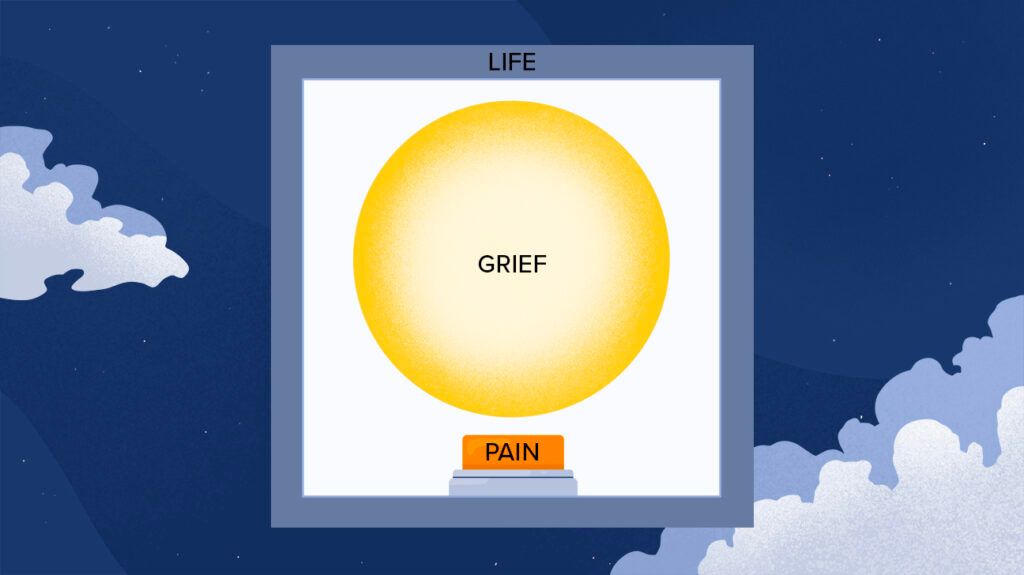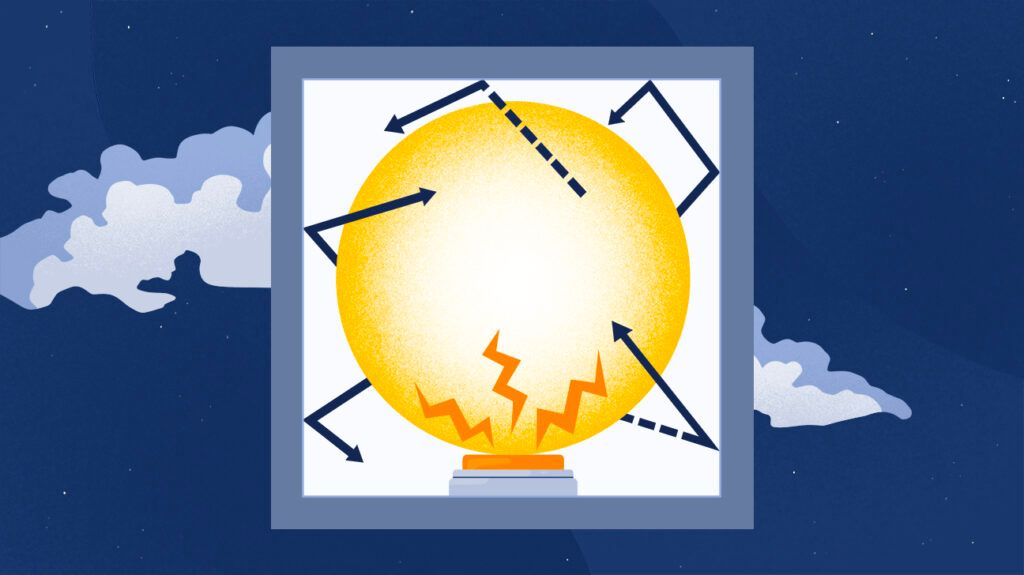Grief is a unique emotion that we all experience. Even if it doesn’t feel like it, it isn’t permanent. It’s like a shrinking ball in a box.
How you navigate grief may depend on many factors — including the emotional tools you have available or the significance of your loss. Your feelings are valid and natural in every case.
That pain may stay with you for the rest of your life, but it’ll likely change over time. That’s the nature of grieving.
In many instances, grief may feel like a bouncing ball in a box with a pain button. Such is the analogy described by Lauren Herschel to explain why grief can hurt so much.

Following Herschel’s analogy, let’s picture your life as a closed box, your grief as a bouncing ball, and pain as a button inside the box.
When you’re first faced with a loss, grief may feel heavy and large, filling out every corner of your life.
Because it’s so present, it’s difficult to ignore or handle. Even if not on purpose, every little step you take may cause the bouncing ball to move and hit the pain button.

You may try to adjust at first. You might take some time for yourself or withdraw from people. Perhaps you try to keep busy to distract your thoughts from the loss.
But because grief is like a bouncing ball, even if you handle it with care, it may still hit the walls of your life and eventually that pain button that sounds the alarm.
How you express that pain may look differently from how someone else does. Maybe you become angry and irritable; possibly, you cry a lot. You may even feel empty or numb, without expressing much at all.
These are all natural expressions of grief.
It may feel like your pain is never going to end and that the huge ball leaves no room for anything else in your life.
You may have a hard time picturing your future without that person, or even finding purpose in moving on.
But that ball that currently feels so large and present has a tiny escape valve. It’ll eventually start losing air.
As time goes on, you may experience grief as a smaller ball. It may no longer get in the way of every other aspect of your life.
Maybe you’re able to go back to work, or tend to yourself and others more efficiently. You may have days when you smile and feel like your “old self.”
But grief is still a bouncing ball. So, from time to time, it may bounce off the box walls and hit the pain button again.
This could take you by surprise, or you may even still move smoothly in life, anticipating the grief ball hitting the button.
There’s no deadline on grieving. This may happen a few weeks after your loss, or even after years have gone by.
And even if the grief ball is smaller, the pain button still delivers the same amount of pain when it gets hit.
You’ve gone back to some old routines, but the loss is still present — and it hurts when you’re confronted by the reality of it.
Even if it didn’t feel like it at first, the grief ball will eventually become minuscule.
The void of your loss is still there, but the space the grief ball used to fill in the box is now occupied by the memories and lessons that person left you.
Love perseveres and serves as a cushion that, more often than not, prevents the ball from hitting the pain button.
The grief ball may still get to it sometimes, and you feel some pain return. But this may be a rare occurrence now.
This is what some people call acceptance.
It doesn’t necessarily mean you’re OK with your loss. It’s valid if you don’t ever feel this way.
You may always miss that person and what they meant in your life. Perhaps you long for their company during important or milestone moments.
This is all natural. It’s also part of the acceptance process to know you still love and need them, but they’re gone.
At some point, you’ve learned to live with the reality of this.
You may have adjusted your life in such a way that other shapes and textures are now filling the box, reducing the chance the grief ball bounces around as much.
Even if it doesn’t feel like it at first, grieving pain decreases with time. It’s like a ball with an escape valve.
This doesn’t mean you have forgotten about your loss or that you care less about it. Instead, healing has taken place and you can acknowledge the loss — but also feel gratitude for what that person meant.
This grieving process is unique to you. There’s no correct or wrong way to do it.
But if you feel you’re having a difficult time, or you’re experiencing prolonged grief, it may be a good idea to reach out for help.
An experienced mental health professional can support you in this difficult time. They can help you develop tools that allow you to shrink the ball and fill the spaces in between.
Remember, you’re doing the best you can with the resources at hand. There’s nothing wrong or uncommon about needing additional support when facing a loss.
Eventually, the bouncing grief ball in a box will start to lose air, and much of its power when it hits the pain button will also go away.
Coping with grief is possible. You can do this.